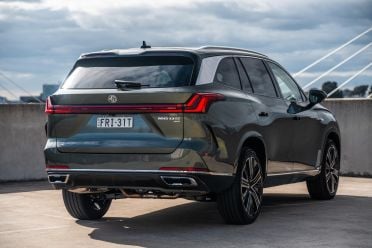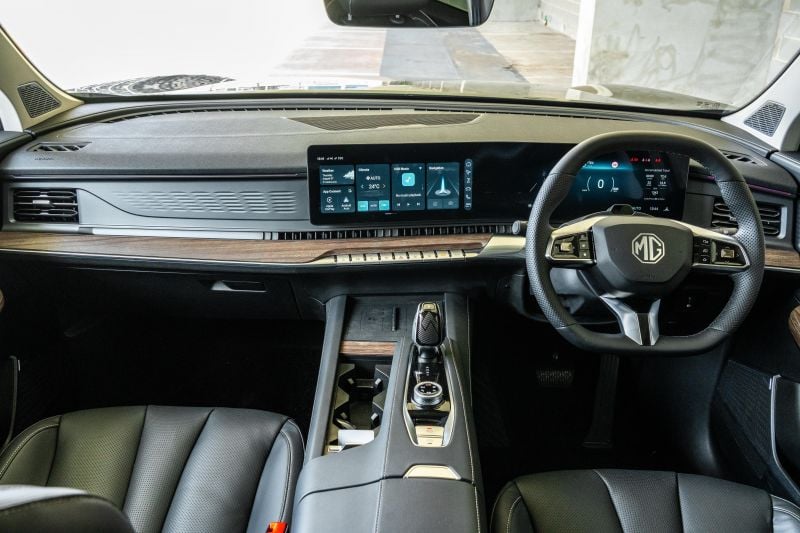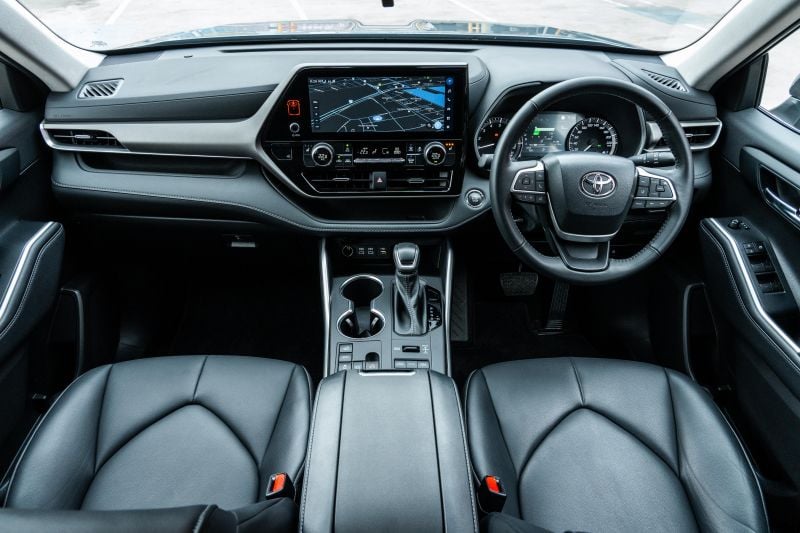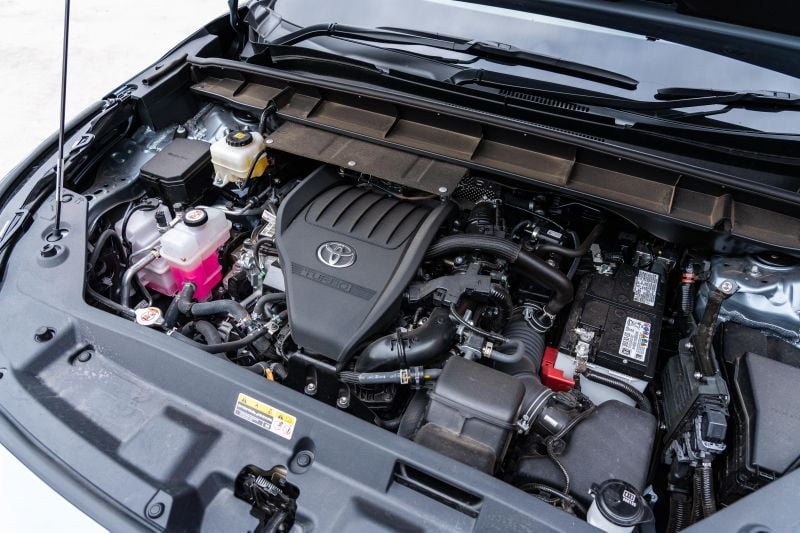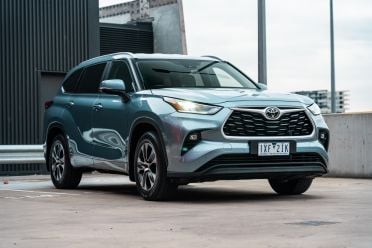As MG spreads its range and reach in Australia, it is moving up and away from its compact-car roots and into some of the toughest and most competitive segments of the showroom wars. It is even bringing a ute.
But it’s the MG QS which takes the depth and variety of its range to another level, targeting families and shifting things up for its sales ambitions in the heartland of the Australian auto landscape.
The QS is MG’s first large SUV and it’s first seven-seater, positioned above smaller MG SUVs like the ZS, S5 EV, and HS.
So it puts MG into a head-on battle with Toyota, and specifically the third-generation Kluger that has long been one of Australia’s most popular large SUVs. There is nothing flashy about the Kluger but it does the job and does it well for anyone requiring sensible and reliable family transport.
The MG QS, in contrast, is considerably bigger than anything else in the brand’s SUV lineup, at least for now, with a spacious seven-seat cabin and the sort of ‘surprise and delight’ features that are winning new fans to the brand across the country.
MG is looking to mount a serious challenge to the Kluger and the Kia Sorento, which finished first and second in the car-based large seven-seat sales segment in 2024 and it has a real contender with the QS.
How much?
There is everything you need, and more, in the QS Essence. It’s the top-grade version in a two-variant lineup, yet still only just tips past $50,000 by the time it hits the road.
Pricing for the entry-level front-wheel drive Excite version of the QS starts at $46,990 drive-away, rising by just $4000 to $50,990 drive-away for the better-equipped all-wheel drive Essence flagship.
In contrast, the Kluger loses the cost comparison with a starting price of $62,410 before on-road costs (and almost $68k once it’s in your driveway) for the most basic GX version. If you want to go all the way to the top, the Grande flagship costs a whacking $85,135 before on-roads ($92,363 drive-away), a full $23k more than the starter car.
Looking around at the rest of the seven-seat SUV crew, the Sorento and its Hyundai twin, the Santa Fe, are also priced close to $60,000 drive-away for the most basic package, while the ute-based off-road contenders are mostly clustered around a $55,000 entry price point, while the benchmark Ford Everest commands an even higher premium.
What do you get?
Both contenders are built around big, family-first bodies that maximise cabin content.
Each also is also based on a unibody platform employing car-style monocoque construction, not the more rugged body-on-chassis ladder-frame approach taken by ute-based large SUVs including the Everest, Toyota Prado and Isuzu MU-X.
That means less off-road capability, but pays dividends in everything from quietness to refinement, as well as the space and comfort afforded to the crucial third-row seating package.
The MG and Toyota both have all-wheel drive (in Essence trim for the MG) and the Kluger has the added benefit of a hybrid driveline, which is now standard across Toyota’s mainstream model range in Australia.
Typically, the QS Essence packs plenty for the price, from leather seat trim, LED lighting and three-zone air-conditioning to 21-inch alloy wheels, and adaptive suspension.
It also has twin 12.3-inch digital screensblended into a single large display that supports wireless phone connectivity with a 12-speaker premium Bose sound system that includes a dedicated rear subwoofer to accentuate a full sound stage.
The Kluger is much the same inside, only with a combination of 8.0-inch and 12.3-inch screens (one for infotainment and the other for the digital instrument display), and there are a total of five USB ports – just like in the QS.
The overall look and feel of the Kluger is cheaper, which is not surprising for a base-level variant and considering its age, and the fact you have to jump all the way to the Grande to get things like a head-up and leather seat trim. Navigation and electric seat adjustment are also missing from the Toyota.
The deeper you dig, the more you find included in the MG, and the more you find missing from the Toyota. Even the alloy wheels are 18-inch items on the Kluger GX, and 20-inch on the MG QS.
Standard equipment they do share includes:
- Automatic LED headlights
- Proximity entry and start
- Wireless Apple CarPlay and Android Auto
- DAB+ digital radio
- Rear privacy glass
- 60:40-split/folding second- and third-row seats
Are they safe?
There is no direct comparison between the Kluger and QS through the Australasian New Car Assessment Program (ANCAP).
The MG is new, and at the time of writing was still making its way through the ANCAP test program, though the brand has openly stated all its new cars are built to achieve maximum five-star ratings.
The Kluger has a five-star ANCAP rating, but it’s based on testing conducted in 2021 and, although its score is valid through to the end of 2027, it was assessed against less rigorous testing and scoring standards, not the latest protocols.
So, the Toyota does not have the very latest ADAS – advanced driver assistance systems – or a front-centre airbag, or an automated warning for approaching cyclists.
The newer safety systems in the MG include a driver attention monitor, rear collision warning and cross traffic alert with auto braking, speed-limit assistance and lane-change assist.
But safety systems they do have in common include:
- Automated emergency braking (AEB) with pedestrian detection
- Adaptive Cruise Control
- Blind Spot Monitoring
- Lane Keeping Assistance
- Forward Collision Alert
- 7 airbags
- Tyre pressure monitoring
What are they like inside?
Seven-seat family SUVs like the QS and Kluger are all about two things: seats and space.
Smaller considerations include third-row air vents and USB outlets plus visibility, storage space and even the flexibility for seat layout in the area behind the five primary spots.
The MG is marketed as a true seven-seater with an adjustable second row on rails that can slide back and forth to extend legroom and comfort for those in the middle or third rows.
The MG and Toyota are both suitable for adults in the third row, which cannot be said for many of their 5+2 rivals that only offer small seats in the back for kiddies or occasional use, making them unsuitable for a Melbourne-Brisbane trek.
The Kluger has plenty of cubbies and other storage, the second-row seats also slide for easy access to the back, and Toyota claims a minimum of 241 litres of luggage space with all seats in place, rising to 552L with the third row folded, and 1150L behind the front seats.
But, being blunt, the Kluger GX is bland. It looks like what it is – the cheapest variant in a three-grade lineup in which all the glitz is reserved for the top end.
The means the look and feel of the plastics, as well as the operation of the controls, isn’t as upmarket.
Over at MG, the QS gets electric seat adjustment – also fitted to the cheaper Excite – and a more luxurious look and feel, with similar practicality to the Kluger. On the space side, the numbers are 203, 517 and 1052 litres of storage, which is slightly less than Kluger in terms of cargo capacity.
What’s under the bonnet?
Both contenders here have an all-wheel drive system, which is good for safety and stability, although only the Toyota has a hybrid powertrain.
The Kluger’s 2.5-litre four-cylinder engine is naturally aspirated, making 142kW of power and 242Nm of torque, which is aided by electric motors on both front and rear axles, and a continuously variable automatic transmission.
Toyota claims combined fuel consumption of 5.6L/100km for a vehicle that weighs in at 2050kg and has a two-tonne towing capacity.
The QS has a turbocharged 2.0-litre four-cylinder engine that makes 153kW and 360Nm, with claimed economy of 8.8L/100km.
It is slightly lighter at 1904kg, but has the same 2000kg towing figure.
The MG only has a space-saver spare, but the Toyota has a full-size replacement.
Cost of ownership
MG offers no less than 10 years or 250,000km of warranty coverage, provided you service at its dealerships every 12 months or 15,000km.
Seven-year servicing costs for the MG run to $2693 in total, averaging around $385 per year.
The Toyota has a five-year, unlimited-km warranty, and roadside assist costs $99 extra each year for up to six years.
Service intervals are 12 months or 15,000km, with five years of service costs capped at $1325, or $265 for each visit.
Both cars require 95-octane premium unleaded.
CarExpert’s Pick
In the past, this would have been a slam-dunk for the Kluger. Not today.
The competition is tougher and far more varied in the family SUV field these days, and the cachet of the Toyota badge has arguably declined as more people look for better value.
Nobody is going to buy either of these seven-seat SUVs to drive them like sports cars; but they will and should check comfort and equipment levels, and do back-to-back comparison work in dealerships to decide which best suits their family needs.
There is better value to be had and more to enjoy in the QS, while the Kluger does what the Toyota badge has always stood for.
MORE: Explore the MG QS showroom
MORE: Explore the Toyota Kluger showroom



